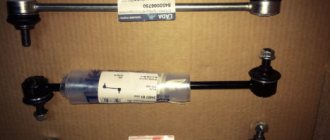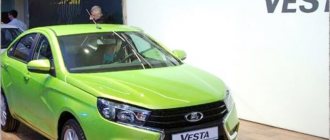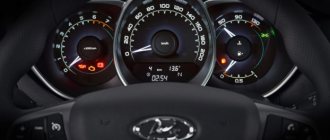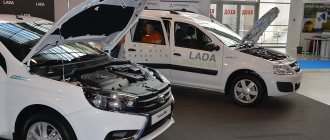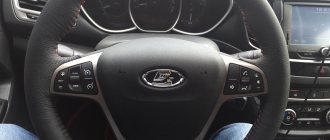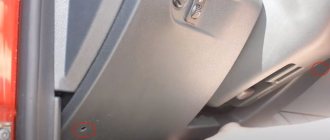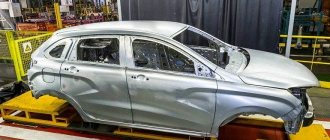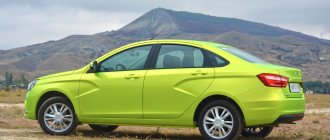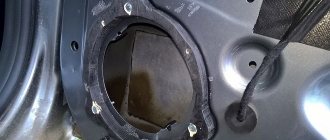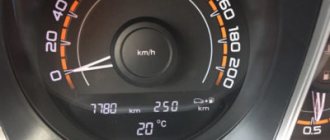The front and rear suspension of Vesta differs significantly from the one that AVTOVAZ used on Grant, Priora, Kalina, etc. All the reviews tell us that the new chassis design is better than before. However, during the first months of operation, the owners began to notice extraneous noises (knocks, creaks, rattles, crunches) in the front and rear suspensions of Vesta, which occur when driving over speed bumps or other road irregularities...
Lada Vesta stabilizer bushings - 9 lifehack points
There is a problem on the Lada Vesta car: the stabilizer bushings (struts) make a squeaking noise.
Needless to say, on modern cars, besides the Lada Vesta, even on expensive ones, the problem of rubber bands is noticeable. The Lada Vesta stabilizer bushings begin to creak well and the struts quickly make themselves known. Creaking, knocking, non-functioning stabilizer bars appear so often on the Lada Vesta car - that AvtoVAZ even answered the question: why Vesta creaks so early. The price for such stabilizer struts and bushings is not high, but the sensations are not pleasant. By the way, the dealer changes the bushings under warranty. What to replace with: as an analogue, stabilizer bars from Kia Rio and Avensis are suitable for Lada Vesta - but this is after warranty. Polyurethane stabilizer bushings have proven themselves better - you can install them. Replacing components with your own hands takes 14 steps, more on them later in the article.
The maximum weight of the Lada Vesta is 1670 kg. The Vesta is equipped with MacPherson strut suspension, a suspension that has been tested over years of operation on different types of vehicles. There is an opinion that the car is simply too heavy; for such stabilizers, they should be more powerful. On the Lada Vesta suspension, the stabilizer bushings are simply not slightly modified to accommodate the weight of the car. To understand the problem, let’s understand the principle of operation of the stabilization system of modern cars. There is nothing complicated about this. Everything works on the principle of a lever, which was invented by Archimedes at the beginning of the last millennium, read the article and find out about it
Let's sort it out
Dismantling operations should be performed in the following order:
- Place the car level on the inspection hole or lift it on a lift so that both front wheels are hanging. This is necessary in order to eliminate the occurrence of stress on the torsion bar. Only after this can you proceed to the next operations.
- Remove the protective cover of the steering mechanism, having previously unscrewed the bolts securing it. After this, access to the mounting points will be greatly simplified.
- Unscrew the lower bolts securing the stabilizer struts and release the struts from their mounting points. You can find videos and instructions where it is recommended to replace old parts with new ones by making a cross-section on them. In this case, the strength of the elements will decrease and they will not be able to perform their functions as expected. In order for the front stabilizer bushings of the Lada Vesta to serve for a long time, you will have to completely disassemble the unit.
- Unscrew the bolts securing the fixing brackets.
- Remove the stabilizer.
Removing the bushing Removing the bushing
Removing the bushing
Removing the bushing
What can be done to get rid of the creaking of stabilizer bushings on the Lada Vesta?
First, you can simply lubricate the rubber bands with grease. WD-40 or any other similar lubricant will work great. However, over time, the creaking will appear again, as the lubricant will dry out or be washed out. Therefore, the procedure will have to be repeated.
Secondly, you can purchase new stabilizer bushings. But it is far from a fact that this will help or solve the problem forever, since the material itself will remain unchanged. And most likely it will also creak over time.
Thirdly, you can install rubber bands of a suitable size from another car. As practice shows, stabilizer bushings from Chevrolet Niva or Kia Rio (Hyundai Solaris) remain suitable options. From Niva, the bushings fit without any modifications, and in order to install Korean rubber bands, you will need to purchase the clamps themselves for them. However, Nivov rubber bands do not always solve the problem, but when installing rubber bands from Kia or Hyundai, you can completely forget about the squeaking of bushings.
This is what the original stabilizer rubber bands look like in comparison with the rubber bands from the Kia Rio:
Articles for ordering: 548132K100 - bushings, 548141W000 - clamps.
Installation
In general, the algorithm for replacing standard stabilizer bushings with an analogue one is simple and, by and large, the same for components from the Chevrolet Niva and for parts from KIA. The only difference is that, in the case of parts from KIA, you will have to install the purchased bracket.
As for the Chevy Niva, the bushings from it will need to be modified - it is necessary to make a slot on the side, and then grind the sides down to the same size as on Vesta.
The replacement process itself begins with installing the Lada Vesta on the overpass, after which you need to thoroughly clean the bolts that secure the stabilizer bar from dirt. Next, you need to arm yourself with a wrench and a Torx T40 bit, with which one bolt from the bracket is completely unscrewed (located further from the steering rack). The second bolt is also unscrewed, but not completely, but enough so that the mounting bracket can be moved to the side.
When the bolts are unscrewed, all that remains is to move the bracket and remove the bushing itself. A pre-prepared bushing is placed in its place, and the bolts are tightened. The second element changes similarly.
This method works provided that components from ChevyNiva are used. If you decide to install bushings from KIA, you will have to completely remove the brackets. In this case, simply unscrewing the bolts will not work, since the screw, which is located closer to the steering rack, rests on the clamp that secures the rack boot.
It can be seen that it will not be possible to unscrew both bolts
In this situation there are 4 options:
- Turn the clamp itself;
- Rotate the boot (together with the clamp, of course);
- Remove the rack protection, then loosen its fastening bolts and slightly lift the rack up;
- Remove the rail completely.
This will allow you to replace the bracket along with the bushing.
As you can see, there are several options for getting rid of creaking Lada Vesta bushings, which differ strikingly in both the effort involved and the financial and time costs.
This form provides general recommendations for eliminating squeaks.
Video about defeating squeaking noise in the Lada Vesta suspension
In addition to these factors, time plays a decisive role.
If the service life of some units has come to an end, then they need to be replaced urgently, since one breakdown can lead to others, and the entire mechanism will go into disarray.
If we return a little to squeaks, then with significant fatigue of the ball joints, steering tip and rack, failure of the shock absorber, or its broken supports, unnatural irritating sounds may appear. Then it is best to go for a diagnosis and then treat the problem.
How to get rid of creaking stabilizer bushings on Lada Vesta
This scheme is incorrect, in my opinion, since it changes the characteristics of the suspension and handling of the car, since no one calculated how non-original parts would behave, and whether this would be dangerous. Nevertheless, many people are tired of driving and creaking for months.
The collective farm scheme is as follows: we remove the stabilizer bushings and the bushing mount (U-shaped bracket that holds the bushing), install bushings 54813-2K100 and bushing mount 54814-1G000 from Kia/Hyundai (you can also install them from Shnivy, but the quality is unpredictable...), they cost depending on the manufacturer (original or not original) from 600 to 3000 rubles for everything.
It is inconvenient to remove and install - the bushings are located on top of the subframe, and not below as usual, you will have to tinker with bolts that are difficult to unscrew due to the nearby rail, but nothing complicated, they will do it for five hundred rubles in any garage service if you don’t want to do it yourself. One could be happy, but in addition to the bushings, the muffler brackets, the rear shock absorber supports, the handbrake cable, the seat back locks, the number frame, the trunk springs, the trunk lock, the front stabilizer struts, and some have already lost their hubs are knocking and creaking...
The correct scheme for resolving the issue: Lada recognizes the problem, releases a new part with the problem solved and, ideally, makes a recall company, or, as complaints are received, promptly resolves (not two or three weeks) the issue of replacing bushings, and also provides obliges dealers to keep a stock of the required parts.
But Lada owners can only dream about this civilized scheme..
Independent work
In this case, there are several ways:
- Bushing lubrication;
- Replacement with analogues.
Bushing lubrication
If you choose this option, everything is done exactly the same as when contacting a dealership. However, car owners choose the lubricant themselves. Some people buy regular mastic, others use foreign lubricants, for example, Japanese ones.
Owners buy different lubricants
Be that as it may, these are only temporary measures, since mastic and other lubricants are still quickly washed out. It may last a little longer, but that doesn't solve the problem.
Replacement with analogues
According to reviews from owners, most often either bushings from Chevrolet Niva or components from KIA are used.
Bushings from Chevrolet Niva
Elements from this model are suitable for Lada Vesta, which can be bought at almost any car store. In addition, they can be ordered online using the following article numbers:
Stabilizer bushings from Chevrolet Niva
The second type of product has larger dimensions, so it is used more often. The price of bushings from Chevrolet Niva is about 150 rubles per pair. However, there are also polyurethane products on sale, which are often painted in bright colors (yellow, red, etc.). The price of polyurethane products reaches 250 rubles per piece.
You can purchase products from one of the resources below:
- https://www.autopiter.ru/goods/21232906046/rossiya/id51385878
- https://niva-lada4x4.ru/product_info.php?products_id=4152
- https://tankomobile.ru/polyurethan-chevy-niva.html
- https://www.nivashop.ru/catalog.html?idc=420&stype=4
However, Vest owners note that elements from the ChevyNiva also often creak, and it doesn’t make much difference what material they are made of - rubber or polyurethane.
Bushings from KIA
These are more expensive components, which can be purchased under article number KSBSOULF or 54813-2K100. The price for such products is significantly higher than for similar ones from ChevyNiva. Usually the cost varies between 400-650 rubles, but the price can reach 850 rubles per piece. Therefore, it is recommended to monitor offers from various suppliers before purchasing. In this case, you need to buy only original products. Purchasing a non-original one is fraught with the same creaking noise, which is extremely unpleasant, because bushings from a Korean manufacturer are not cheap.
You can purchase them on one of the following sites:
- https://koreanaparts.ru/product/548132K100/730
- https://www.autodoc.ru/part/hyundai-kia—647/548132k100/
- https://www.autopiter.ru/goods/548132k100/hyundai-kia/id11105217
- https://plentycar.ru/autopart/1981834
In addition, it is worth taking into account the configuration of parts from HYUNDAI-KIA, which differs significantly from that of the Lada Vesta. For this reason, along with the bushings, you need to buy brackets for them, which are sold under article number 54814-1G000. The price tag for them ranges from 300 to 500 rubles per piece.
Comparison of Russian and Korean elements
You can order brackets online at the following addresses:
- https://koreanaparts.ru/product/548141G000/730
- https://nomer52.ru/kronshtejn-vtulki-stabilizatora_hyundai_elantra-hd_548141g000_mobis_i126/
- https://www.autodoc.ru/part/hyundai-kia—647/548141g000/
- https://www.autopiter.ru/goods/548141g000/hyundai-kia/id11105233
Bracket for bushings from Kia
How to get rid of crunching?
To get rid of the crunch, you can go two ways:
- Make rotation of the stabilizer in the bushing silent.
- Limit the movement of the stabilizer.
Let’s talk about the first method, and I’ll say right away that it was not possible to achieve any special results here. Options for replacing factory stabilizer bushing kits. Before replacement, it is recommended to matt (remove the gloss, but not the entire layer of metal) the seating surface for the bushings.
Polyurethane bushings . As you know, polyurethane is much stiffer than ordinary rubber bands and has the ability to “eat” metal. Those who installed polyurethane from Tochka Opory and other manufacturers still noticed extraneous sounds, either in dry or wet weather.
Bushings with bracket from Rio . Rubber band number 54813-2k100 clamps 54814-1g000. Same situation. The material is much stiffer than the factory ones, but it was not possible to completely get rid of the problem.
The second method remains - to limit the movement of the stabilizer.
Replacing the springs with shorter ones (example -50mm). Replacing the springs reduces the suspension travel, and accordingly, squeaks disappear, but in this way you will get rid of the informative suspension, which many have already come to love on Vesta, coupled with its handling.
All that remains is to wait for the decision of the factory, and I hope that they will get rid of this problem in the shortest possible time, just as they got rid of knocking noises in the rear suspension by upgrading the relevant elements.
Let's summarize
As you can see, the work is simple and accessible even to a beginner; it is important to first understand the stabilizer circuit and understand how to fix the malfunction. Factory elements are made of rubber. To replace it, it is better to buy polyurethane elements; their service life is up to 4 times longer compared to rubber parts. Elements made of polyurethane are resistant to chemicals, water, and can withstand high loads. In addition, they maintain operational parameters at sub-zero temperatures, which ensures vehicle stability and controllability on the roads in winter.
How to remove the creaking of stabilizer bushings on Lada Vesta?
All methods can be divided into 2 groups:
- reworking old parts;
- installation of new spare parts.
The most effective way to get rid of squeaking and knocking noises is to install new bushings or stabilizer assembly. You just need to choose the parts that are suitable for the Lada Vesta.
The simplest and most unstable methods are to apply lubricant or tighten the clamps, reducing its stroke.
First, let's look at the simplest solutions possible.
Lubricate the bushing
Some car owners followed the dealer's example. But we decided to choose and apply the lubricant ourselves. Sometimes this really solves the problem, for a couple of thousand kilometers. But as a result, the lubricant, regardless of its type, is washed out or scooped out, and the unpleasant noise returns.
Tighten the clamps and reduce the free play of the stabilizer
To remove the squeak, you need to tighten the bushing clamps on a loaded car. Without using a lift, the car must not be suspended. If you tighten the clamps tightly, the free play of the stabilizer will decrease significantly and the creaking will become quieter. But over time, the clamps will stretch and the extraneous noise will return.
Replace bushings
To eliminate creaking and knocking, you can simply replace the defective part with a new one. According to reviews from Lada Vesta owners, you can install spare parts from Chevrolet, Renault or Kia.
We recommend installing bushings from Kia. The parts are significantly higher quality than factory ones from AvtoVAZ. When replacing, you will also need new brackets.
After installing new spare parts, extraneous noise will disappear completely or become significantly quieter. Owners of Lada Vesta claim that the difference with the “factory bushings” is huge.
Install a new stabilizer link
Unpopular but effective solution. To eliminate play of the stabilizer inside the bushings, you can install a stabilizer with sealed bushings. When replacing, you will also need 2 brackets from Lada.
Compared to simply replacing bushings, this method is more effective. But also noticeably more expensive.
If you want to remove squeaking, we recommend the last 2 methods. Replacing bushings or stabilizer. This is the only way to solve the problem for a long period of time. Comfortable driving and the absence of extraneous noise are more expensive than a couple of new spare parts.
To correctly install new parts and accurately remove squeaks, you can contact the StoVesta specialists. Replacing the front bushings takes approximately 30 minutes and costs only 300 rubles for 1 bushing (240 for the “Pleasant acquaintance” promotion).
We collect
After lubricating the surface of the stabilizer with soap or lubricant, the bushings are installed. They should fit tightly, without play. After making sure that everything is in order, we assemble the unit in the reverse order:
- We install the stabilizer in place.
- We install the brackets securing the bushings. We tighten the bolts securing them.
- We fix the ends of the struts to the stabilizer. We tighten them.
- Only after this do we tighten the bracket bolts with a force of 1.8–2.4 kgf. m. Do not overdo it, otherwise you will break the threads in the mounting holes!
- We install the protective cover of the steering mechanism.
Replacing the Lada Vesta stabilizer bushings is a simple job. If it is done correctly, the service life of the stabilizer bushings will increase several times. You can extend the life of important parts by carefully monitoring their cleanliness and promptly removing contamination. Both rubber and polyurethane elements are especially sensitive to the ingress of engine or transmission oil.
Rate the article!
Front suspension device
First, let's look at the suspension design and the role of the anti-roll bar in it. The front suspension on the car is independent, with double-acting gas-filled struts complete with barrel springs. Here, for the first time for AVTOVAZ, a subframe appeared, on which the lower wishbones, two engine mounting points and the sensational anti-roll bar were located. It is the latter that we will talk about in this article.
Number six (6) is the anti-roll bar, the purpose of which is to eliminate roll when cornering. It is attached using a rubber-metal structure, which is the culprit of our creaking. When the stabilizer rotates, friction and creaking are generated inside the rubber bushing, which we hear. Below is a photo of the bushing that is installed at the factory.
As practice has shown, such a design feature appears after 1000-1500 km in only 60% of all purchased cars. When applying for a warranty, the dealer simply disassembles the mechanism, fills the bushings with PMS 400 lubricant (emulsion-based) and puts the unit back together. This “rework” is enough for 100-200 km, depending on how often you drive in wet weather.
Why do you still need to replace?
Let's return to the principle of operation of the car's lateral stability unit. When the outer wheel turns, the force of inertia pulls the outer wheel in the direction opposite to the turn, and the inner one tries to break away from the road. Thus, the suspension of the outer wheel is compressed, which forces the stabilizer to rotate upward. This means that the part of the stabilizer closest to the turn attracts the wheel to the road, which, thanks to the force of inertia, tries to break away from the road. The stabilizer lever rotates inside the bushings. There is no point in explaining further why timely repair of failed elements of the stabilization system with high-quality new ones is necessary.
Lada Vesta replacement stabilizer bushings
You may know that many cars contain stabilizer bars (beams) in their design - either on the front axle or on both.
On Vesta, stabilizers (beams) of lateral stability are installed by the factory only at the front.
The stabilizer is designed to combat lateral rolls (for example, during a turn), preventing a possible rollover. With such a beam, the car has greater stability on the road, and you are less likely to lose reliable grip on the road.
The stabilizer kit includes the following elements:
- Barbell
- Mounting bracket (clamp)
- Bushing (cushion)
- Rack
- Mounting bolt
The stabilizer bar for Vesta is made of spring steel, which is installed on the subframe using brackets and bushings. The rod is also attached to the front suspension shock absorbers with appropriate struts.
During the lateral tilt of the machine, the stabilizer links move (one moves up, the other moves down), resulting in an even distribution of the load between the chassis parts.
In this case, the stabilizer bushings play a very important role - they allow the bar to twist around its axis during load, ensuring stabilization of the car’s position on the road.
The bushings are replaced if they are worn out. The results of wear can be:
- Extraneous sounds from the front suspension.
- Creaking occurs when driving on uneven roads or after driving through puddles.
- Reduced controllability in the speed range from 60 to 90 km/h.
The causes of wear are the aggressive action of the environment (road dirt, reagents) or poor manufacturing quality of the bushings.
When should you change bushings?
Routine work to replace these elements, according to AvtoVAZ recommendations, should be carried out after 25-30 thousand kilometers.
In practice, they often have to be changed more often . At the slightest suspicion, it is necessary to inspect the bushings for cracking or destruction of the rubber. If the bushings do become unusable, you cannot put off replacing them, because the technical condition of the suspension directly affects both the quality of driving and traffic safety.
Factory bushings are made of rubber. If they wear out, we recommend installing new polyurethane products, since they are not subject to such intense wear, have increased resistance to the negative effects of aggressive environments (water, acids, oils, gasoline, reagents, etc.), and do not deform under high loads , and also do not lose their plastic properties over a wide temperature range.
How to correctly change the Lada Vesta SPU airbags?
Installation of fog lights on Lada Vesta.
tips and recommendations from experts The technology for performing repair work on changing the rubber pads of the stabilizer bar is simple and accessible to the vast majority of motorists. Of course, if the car is under warranty, then this should be done by the mechanics of the dealer's car service center.
Preparatory activities
To carry out repair procedures, you do not even need to remove the engine protective apron. However, no one has canceled the availability of a small set of tools; for work you will need:
- Torx key T40.
- Ring wrench “16”.
- Socket wrench “13”.
- Driver, extension and 10mm socket.
- Silicone Grease.
For a comfortable and high-quality replacement of faulty stabilizer bushings on a Lada Vesta car, you need at least an inspection hole or overpass, and in the best case, a lift. Before putting the car in for repairs, it is worth washing it thoroughly, especially in the area where the work is being carried out.
Technology system
It is important to remember one important detail - you need to start changing the SPU rubber cushion only when the stabilization bar is in a relaxed state. This happens when the front wheels are suspended or the entire mass of the vehicle is loaded evenly on an overpass or pit.
After this condition is met, the process proceeds according to the following scheme:
- Using a wrench, an extension and a 10mm socket, unscrew the five bolts securing the steering gear protective cover.
- Unscrew the two rear bolts securing the mounting brackets for the cushion and the rod using a 13mm spanner.
- Using a Torx T40 ratchet wrench, unscrew the two front bolts on the brackets (on the steering rack side).
- Dismantle the bracket and remove the old bushings.
- Make a cut in the bottom of the new cushions.
- Treat the inner surface of the holes in the pads with silicone grease and put them on the bar.
- Tighten the fastening nuts in the reverse order, tightening torque - 1.8-2.4 kgf.m.
Judging by the reviews of “vestavods”, the service life of polyurethane products is 3-4 times higher than that of rubber ones. Such pillows retain elasticity and resilience even at low temperatures, which guarantees the stability of the car, as well as a high level of its handling.
According to a survey, more than 60% of owners of the Lada Vesta sedan experience creaking in the front suspension. The source of extraneous noise is the rubber bushings of the anti-roll bar. Currently, AvtoVAZ solves the problem with lubricant. Those who consider this method ineffective replace the Vesta stabilizer bushings with analogues.
